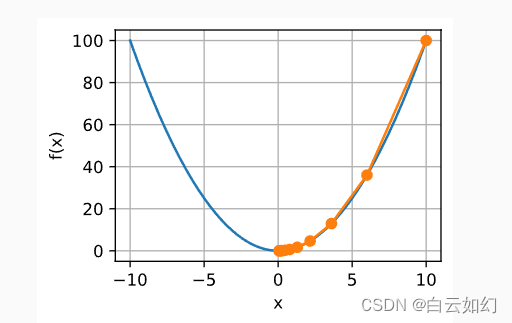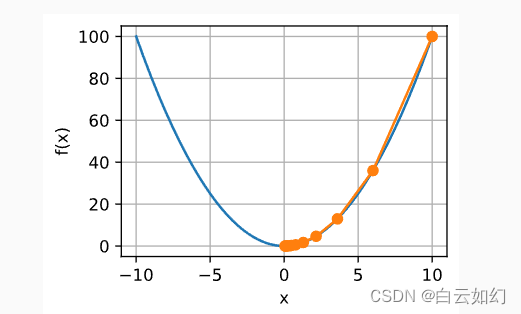梯度下降
尽管梯度下降(gradient descent)很少直接用于深度学习, 但了解它是理解下一节随机梯度下降算法的关键。 例如,由于学习率过大,优化问题可能会发散,这种现象早已在梯度下降中出现。 同样地,预处理(preconditioning)是梯度下降中的一种常用技术, 还被沿用到更高级的算法中。 让我们从简单的一维梯度下降开始。
下面我们来展示如何实现梯度下降。为了简单起见,我们选用目标函数。 尽管我们知道
时
能取得最小值, 但我们仍然使用这个简单的函数来观察
的变化。
%matplotlib inline
from mxnet import np, npx
from d2l import mxnet as d2lnpx.set_np()def f(x): # 目标函数return x ** 2def f_grad(x): # 目标函数的梯度(导数)return 2 * x%matplotlib inline
import numpy as np
import torch
from d2l import torch as d2ldef f(x): # 目标函数return x ** 2def f_grad(x): # 目标函数的梯度(导数)return 2 * x%matplotlib inline
import numpy as np
import tensorflow as tf
from d2l import tensorflow as d2ldef f(x): # 目标函数return x ** 2def f_grad(x): # 目标函数的梯度(导数)return 2 * x%matplotlib inline
import warnings
from d2l import paddle as d2lwarnings.filterwarnings("ignore")
import numpy as np
import paddledef f(x): # 目标函数return x ** 2def f_grad(x): # 目标函数的梯度(导数)return 2 * x接下来,我们使用作为初始值,并假设
。 使用梯度下降法迭代\(x\)共10次,我们可以看到,
的值最终将接近最优解。
def gd(eta, f_grad):x = 10.0results = [x]for i in range(10):x -= eta * f_grad(x)results.append(float(x))print(f'epoch 10, x: {x:f}')return resultsresults = gd(0.2, f_grad)epoch 10, x: 0.060466
def gd(eta, f_grad):x = 10.0results = [x]for i in range(10):x -= eta * f_grad(x)results.append(float(x))print(f'epoch 10, x: {x:f}')return resultsresults = gd(0.2, f_grad)epoch 10, x: 0.060466
def gd(eta, f_grad):x = 10.0results = [x]for i in range(10):x -= eta * f_grad(x)results.append(float(x))print(f'epoch 10, x: {x:f}')return resultsresults = gd(0.2, f_grad)epoch 10, x: 0.060466
def gd(eta, f_grad):x = 10.0results = [x]for i in range(10):x -= eta * f_grad(x)results.append(float(x))print(f'epoch 10, x: {float(x):f}')return resultsresults = gd(0.2, f_grad)epoch 10, x: 0.060466
对进行优化的过程可以绘制如下:
def show_trace(results, f):n = max(abs(min(results)), abs(max(results)))f_line = np.arange(-n, n, 0.01)d2l.set_figsize()d2l.plot([f_line, results], [[f(x) for x in f_line], [f(x) for x in results]], 'x', 'f(x)', fmts=['-', '-o'])show_trace(results, f)[07:12:32] ../src/storage/storage.cc:196: Using Pooled (Naive) StorageManager for CPU

def show_trace(results, f):n = max(abs(min(results)), abs(max(results)))f_line = torch.arange(-n, n, 0.01)d2l.set_figsize()d2l.plot([f_line, results], [[f(x) for x in f_line], [f(x) for x in results]], 'x', 'f(x)', fmts=['-', '-o'])show_trace(results, f)
def show_trace(results, f):n = max(abs(min(results)), abs(max(results)))f_line = tf.range(-n, n, 0.01)d2l.set_figsize()d2l.plot([f_line, results], [[f(x) for x in f_line], [f(x) for x in results]], 'x', 'f(x)', fmts=['-', '-o'])show_trace(results, f)
def show_trace(results, f):n = max(abs(min(results)), abs(max(results)))f_line = paddle.arange(-n, n, 0.01, dtype='float32')d2l.set_figsize()d2l.plot([f_line, results], [[f(x) for x in f_line], [f(x) for x in results]], 'x', 'f(x)', fmts=['-', '-o'])show_trace(results, f)







)



![[操作系统] 面试宝典之~死锁连环系列](http://pic.xiahunao.cn/[操作系统] 面试宝典之~死锁连环系列)







